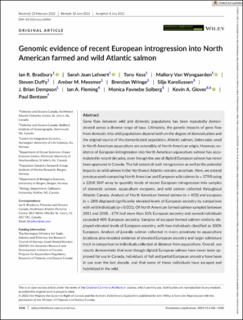| dc.description.abstract | Gene flow between wild and domestic populations has been repeatedly demonstrated across a diverse range of taxa. Ultimately, the genetic impacts of gene flow from domestic into wild populations depend both on the degree of domestication and the original source of the domesticated population. Atlantic salmon, Salmo salar, used in North American aquaculture are ostensibly of North American origin. However, evidence of European introgression into North American aquaculture salmon has accumulated in recent decades, even though the use of diploid European salmon has never been approved in Canada. The full extent of such introgression as well as the potential impacts on wild salmon in the Northwest Atlantic remains uncertain. Here, we extend previous work comparing North American and European wild salmon (n = 5799) using a 220 K SNP array to quantify levels of recent European introgression into samples of domestic salmon, aquaculture escapees, and wild salmon collected throughout Atlantic Canada. Analysis of North American farmed salmon (n = 403) and escapees (n = 289) displayed significantly elevated levels of European ancestry by comparison with wild individuals (p < 0.001). Of North American farmed salmon sampled between 2011 and 2018, ~17% had more than 10% European ancestry and several individuals exceeded 40% European ancestry. Samples of escaped farmed salmon similarly displayed elevated levels of European ancestry, with two individuals classified as 100% European. Analysis of juvenile salmon collected in rivers proximate to aquaculture locations also revealed evidence of elevated European ancestry and larger admixture tract in comparison to individuals collected at distance from aquaculture. Overall, our results demonstrate that even though diploid European salmon have never been approved for use in Canada, individuals of full and partial European ancestry have been in use over the last decade, and that some of these individuals have escaped and hybridized in the wild. | en_US |
